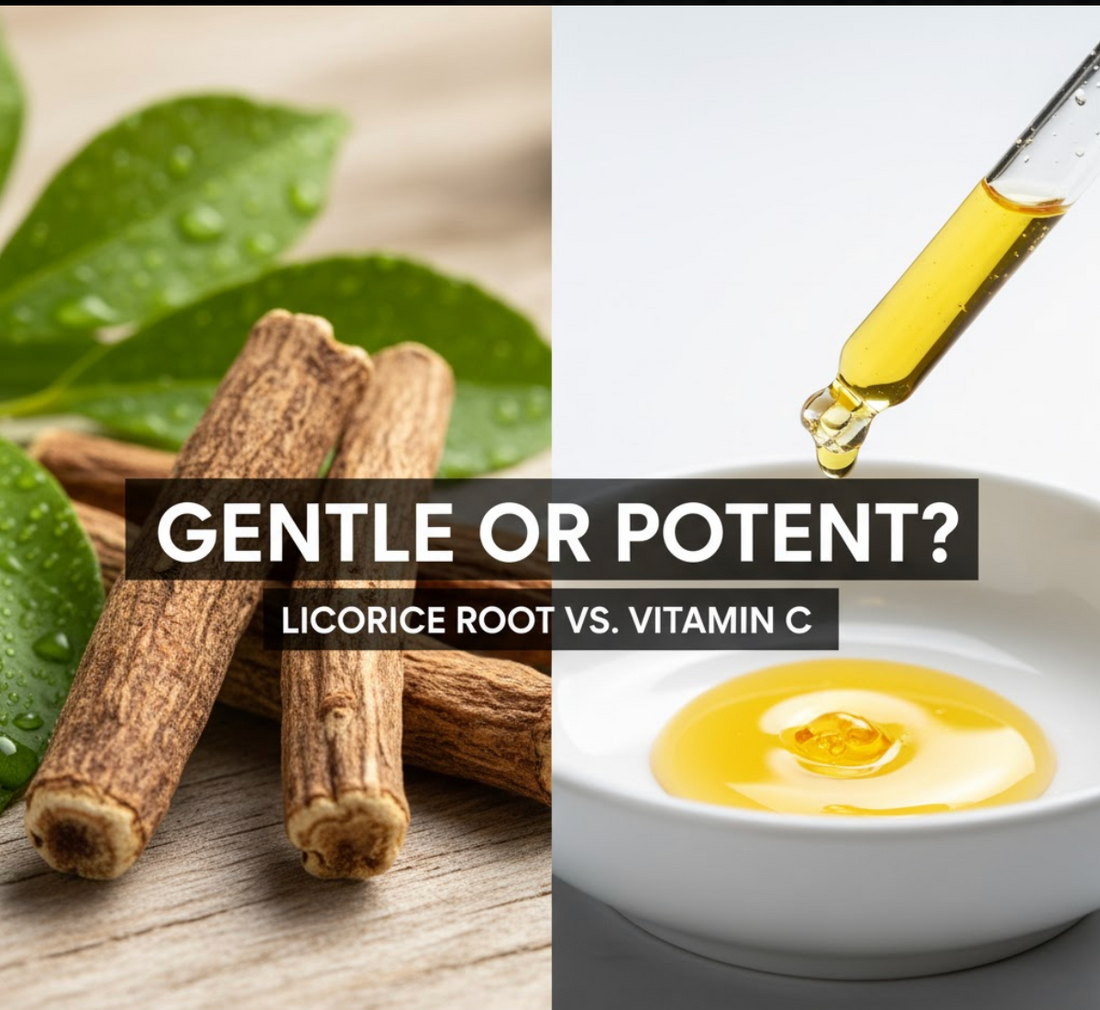
Licorice Root vs. Vitamin C: The Natural and Scientific Approach to Fading Dark Spots
TrueBliss SkincareThe desire for an even, bright, and luminous complexion is universal. For those battling dark spots, sun damage, and post-acne marks (hyperpigmentation), the skincare aisle offers two superstar solutions: Vitamin C and Licorice Root.
While both are heroes at brightening, their mechanisms, side effects, and suitability for different skin types vary significantly. At TrueBliss Skincare, where we merge Ayurvedic tradition with modern science, we believe in understanding both approaches to achieve the best results.
Let’s delve into the global understanding, benefits, pros, and cons of these two powerhouse ingredients.
1. The Scientific Champion: Vitamin C (Ascorbic Acid)
Globally, Vitamin C is the gold standard in brightening and antioxidant protection. Its most potent form, L-Ascorbic Acid (LAA), is a well-researched ingredient crucial for skin health.
Global Understanding & Benefits
Vitamin C is a powerful antioxidant that protects the skin from free radical damage caused by UV rays and pollution. Its primary mechanism for fading dark spots is through tyrosinase inhibition (the enzyme responsible for melanin production) and accelerating cell turnover. It's also renowned for boosting collagen synthesis, which improves overall skin texture and firmness.
Pros
-
High Efficacy: When formulated correctly (typically at concentrations of 10% or more), Vitamin C delivers rapid, visible brightening and anti-aging results.
-
Multi-Tasker: It brightens, firms, and offers strong antioxidant protection all in one step.
-
Scientific Backing: It has decades of rigorous, peer-reviewed research supporting its efficacy.
Cons
-
Instability: Vitamin C (especially LAA) is highly unstable. It easily oxidizes when exposed to light, heat, or air, turning brown and becoming ineffective—or worse, pro-oxidant.
-
Potential Irritation: LAA requires a low pH to penetrate the skin, which can cause stinging, redness, and irritation, especially for sensitive or rosacea-prone skin.
2. The Ayurvedic Hero: Licorice Root Extract
Licorice Root, derived from the Glycyrrhiza glabra plant, has been used for centuries in traditional Chinese medicine and Ayurveda for its soothing and healing properties. It is the gold standard for gentle, natural brightening.
Global Understanding & Benefits
Licorice Root contains several key compounds, notably Glabridin and Liquiritin.
-
Glabridin: This compound is a highly effective tyrosinase inhibitor—it prevents the skin from producing excess pigment after exposure to triggers (like sun or acne).
-
Liquiritin: This compound works differently by helping to break up and disperse existing melanin clusters in the skin, which helps fade current dark spots.
-
Anti-Inflammatory: Perhaps its greatest advantage is its potent anti-inflammatory action, which calms irritation and redness. Since inflammation is the primary trigger for dark spots in sensitive and darker skin tones (Post-Inflammatory Hyperpigmentation or PIH), Licorice Root is an ideal preventative.
Pros
-
Exceptional Gentleness: It is remarkably well-tolerated by almost all skin types, including sensitive, reactive, and rosacea-prone skin.
-
Safe for Darker Skin Tones: Due to its calming effect, it poses a much lower risk of causing irritation that could lead to new dark spots, making it safer for darker complexions.
-
Soothing: It actively reduces inflammation while it brightens.
Cons
-
Slower Results: Results are typically more gradual compared to high-concentration LAA formulas. Consistency is key.
-
Potency Variation: Efficacy depends heavily on the quality and concentration of the Glabridin extract used by the formulator.
The TrueBliss Approach: Merging Gentle Tradition and Scientific Efficacy
At TrueBliss Skincare, we believe the best approach is often a balanced one, where nature’s gentleness meets scientific efficacy.
We choose ingredients that are effective but align with our toxin-free, handmade ethos, prioritizing safety for sensitive skin.
Pigmentation Cream: Licorice Root + Kojic Acid
Instead of relying solely on the sometimes-irritating L-Ascorbic Acid, our Pigmentation Face Cream utilizes Licorice Root Extract alongside Kojic Acid and Rosehip Oil.
-
Licorice Root (The Gentle Inhibitor): Provides the soothing, preventative power needed to calm the skin and stop the initial inflammation that leads to dark spots.
-
Kojic Acid (The Scientific Lightener): Kojic Acid, derived from fungi, is a powerful tyrosinase inhibitor (like Vitamin C), offering strong scientific efficacy without the volatility or high acidity of LAA.
-
Rosehip Oil: Adds intense nourishment and assists in cell regeneration.
This combination allows our cream to deliver powerful, visible brightening results while maintaining the gentleness and stability that TrueBliss Skincare is known for. You get the efficacy of science and the soothing power of Ayurveda.
Summary: Which One Should You Choose?
|
Feature |
Vitamin C (L-Ascorbic Acid) |
Licorice Root Extract |
|---|---|---|
|
Primary Action |
Antioxidant Protection & Collagen Boost |
Anti-inflammatory & Pigment Dispersion |
|
Efficacy |
High (Often faster) |
Moderate to High (Requires consistency) |
|
Gentleness |
Low to Moderate (Can cause irritation) |
High (Excellent for sensitive skin) |
|
Stability |
Low (Requires careful packaging) |
High (Very stable and easy to formulate) |
|
Best For |
Experienced users, anti-aging, firming |
Sensitive skin, darker skin tones (PIH prevention) |
Ultimately, both are exceptional brightening ingredients. If your skin is sensitive and prone to redness, Licorice Root is your safest, most effective bet—and that’s why it’s a star in our TrueBliss Pigmentation Face Cream.
Tags
#LicoriceRoot #VitaminC #Hyperpigmentation #DarkSpots #SkincareScience #Ayurveda #TrueBlissSkincare #PigmentationCream #GlowUp #SensitiveSkin
